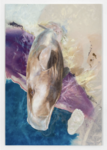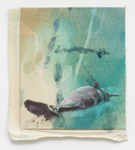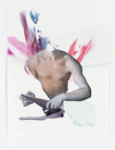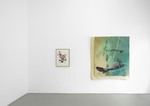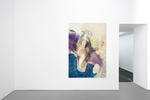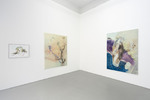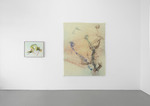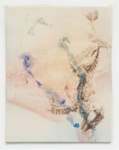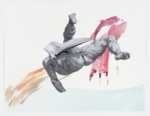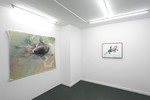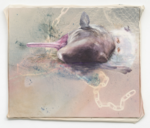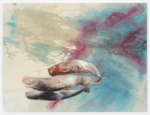Kim Nekarda - net entanglement
By Bernd Reiss
Translation Rasmus Kjelsrud
1. Net
In the exhibition title "net entanglement", Kim Nekarda refers to nets drifting uncontrolled in the oceans.
Much of the plastic waste in the oceans consists of fishing gear such as nets and ropes. A fishing net that has been lost while fishing or deliberately discarded in the ocean and is floating around or entangled on the seabed is called a "ghost net". Ghost nets are not only a part of the growing mountain of trash swimming in the oceans, achingly slow decomposing into harmful micro-plastics. They are also a deadly hazard to all marine life that gets caught in them, whether whales, sharks, seals, turtles or seabirds.¹
2. Canvas / Arrangement of surface
At first glance, the canvas fabric appears quickly and provisionally stretched onto the stretcher frame. The surplus margins are not laid around the stretcher, but flap over at the sides. The canvas is glazed in light colours as if dipped in monochrome colour mist; colours overlap. The light beige of the cotton fabric occasionally shimmers through from the monochrome areas and sometimes structures and patterns are reminiscent of nets. Areas of colour, splashes and streaks, traces of body prints, painted body fragments or outlines of arms, hands, legs or feet, animal skeletons as well as whales and dolphins combine or overlap.
3. Painting ground / Colour
The monochrome painting ground looks like a mist of pastel colours, of various light shades of blue that oscillate from turquoise and ice blue to light grey. Light pink or yellow tones also cover the ground. The colour blue is usually associated with the sky, as well as with water or the sea, and, consequently, with distance, longing and melancholy.
The whole palette of pastel colours is reminiscent of the Arctic sky. These (twilight) colours can be traced back to the light scattering of the various components of the atmosphere.² Artists such as Claude Monet, Caspar David Friedrich, William Turner or Olafur Eliasson have taken up the diverse play of colours in nature, but have also given it a romantic, ethereal or spiritual charge.
4. Body print / Image
"For the last fifteen years I have started each painting with a print of my own naked body. This is not only about leaving marks, but also about making myself vulnerable."
Kim Nekarda³
The canvas is not stretched on the stretcher frame, but spread out flat on the floor when the artist lays his body, rubbed with paint, on it. The rubbing in of the skin is reminiscent of a washing process, although actually exactly the opposite is achieved. Instead of cleaning the skin, he "soils" it with paint. His body functions like a printing plate - the "body print", however, not as a self-portrait.
Each of these body prints gives a different view of the body and reveals the fine structures of the skin surface and its folds. On the one hand, the imprint conveys an authentic, direct contact of the body with the canvas, a direct depiction; on the other hand, the paint seems to dissolve the body. Although the representations also achieve a remarkable plasticity, the image contains more the trace than an illusion of the real body and only allows its wholeness to be guessed at. This tension between the direct physical commitment and the withdrawal of the body in its pictoriality, to only being recognizable as a trace, constitutes the artistic quality of the body print.⁴
When Kim Nekarda, instead lays the outline of his body on the canvas by spraying the paint, this "body image" resembles the shadow of his existence. The contour of the torso becomes an abstracting reality.
However, Nekarda does not understand the body (his body) as a "living brush” like Yves Klein understands the bodies of his female models, but also knows how to critically address and question the relationship of his pictorial approach to the classical tradition of nude painting.
If his body now is rendered in paint, it is fragmented, concentrated on torso and limbs; never is the head admitted. It is always his own body, but this appears neither voyeuristic nor narcissistic or autoerotic. The body always appears in his paintings more as a trace than an optical reproduction in photographic quality, and so the body seems to oscillate between existence and disappearance. The dissection of the body, however, is not only a reference to man's alienation from his body, but could also be read as a metaphor for man's distanced relationship to our planet Earth.
5. The sea / The whale
Kim Nekarda has been working with the sea for many years, and the whale is a frequently recurring motif.⁵
Representations of the sea in art history up to the 20th century are merely the depiction of the outer surface as seen from boat, ship or mainland. The actual three-dimensional space of the ocean is a very rare and necessarily imaginary subject in art. In history painting, the sea is the site of events, such as naval battles. In Romanticism, the sea is symbolically charged, artistically transfigured or reinterpreted as a metaphor for the human journey through life. Shipwreck, actually the result of catastrophic impact of natural forces, becomes a synonym for a failed life or disappointed hope.
In still life painting, which has developed into its own genre since the 17th century, there are time and again depictions of fish. Besides "normal" fish, however, it is usually the grotesque and monstrous-looking sea creatures, cephalopods and crustaceans that arouse interest. Octopuses and giant squid in particular have inspired a whole genealogy of sea monsters, and the whale was also seen in this category of sea monsters. There is already in the Bible mentions of a sea monster that is said to have swallowed the prophet Jonah, and after three nights and days spat him out again alive. In Luther's translation, this monster appears as the "whale". Depictions of this legend can be found in medieval Bible manuscripts but also in Renaissance paintings. Images of stranded whales can be found in copperplate engravings of the 17th and 18th centuries, whereby also here the marine mammal appears monstrous and terrifying. In William Turner's work, the whale is a motif with which he repeatedly grappled throughout his career. - Here it is above all whaling that he captures in his paintings. Turner also sees the whale primarily as a sea monster. It was probably the size of these animals that occasioned fear in people and made them believe that whales were aggressive and dangerous man-eating monsters.
It was not until the second half of the 20th century that this view changed in many countries and regions of the world. This radical socio-political change in values is one of the greatest achievements of species conservation. Today, whales are seen as intelligent and gentle giants with complex empathic abilities.
While we humans are just beginning to explore the marine habitat and the depths of the oceans, we are at the same time witnessing a dramatic decline in marine diversity due to maximum exploitation and overfishing, but also a worldwide dying of coral reefs due to the warming of the world's oceans⁶, in addition to pollution by toxic wastewater, with pesticides, herbicides, artificial fertilisers, cleaning agents, untreated wastewater from industry and households, by radioactive pollutants⁷ or oil, as well as the dumping of waste⁸, especially plastic waste. It is estimated that around 675 tons of waste end up in the oceans every hour - half of which is plastic.⁹
________________________
¹ Seaspiracy, Dokumentay film USA 2021, Director: Ali Tabrizi.
² see: Kim Nekarda, Spitzbergen, Å+, Berlin 2019.
³ Kim Nekarda in an Email to the Author.
⁴ The imprint of the body also reminds us of two "icons" of Christian tradition:
The Veil of Veronica and the Shroud of Turin. According to legend, Veronica handed Jesus a cloth on the way to Golgotha to wipe the sweat and blood from his face. In the process, Jesus' face is said to have been miraculously imprinted on the sweat cloth as the so-called "Vera Icon", the "True Image".
The Turin Shroud, on the other hand, shows the full-body image of the front and back of a human being. According to legend, it is the burial shroud of Jesus. Today, however, it is also seen by the church as a painting from the 12th century.
⁵ There are about 90 species of cetaceans, divided into two groups: Baleen whales and toothed whales, which also includes dolphins. Whales are found in all the world's oceans. However, they are not descended from fish, but belong to the category of mammals, just like us humans. A clearly recognisable anatomical distinguishing feature is the horizontal tail fin of whales, in contrast to its vertical orientation in fish. This sea mammal’s predecessor was hairy, had four legs and lived on land. 55 million years ago climatic upheaval caused a rise in sea level and desertification of large stretches of land as a consequence. These changes in the eventually lead this species walked back into the oceans, to conquer it as their new habitat. The perfect adaptation to the habitat however, took place over millions of years.
⁶ see Federal Ministry for the Environment, Nature Conservation and Nuclear Safety: https://www.bmu.de/themen/bildung-beteiligung/bildungsservice/aus-der-wissenschaft/korallenriffe-im-klimawandel/
⁷ According to Greenpeace, 1.5 million litres of radioactively contaminated water per day are discharged into the English Channel from the reprocessing plant in La Hague, France. Sellafield pumps 9 million litres of radioactively contaminated wastewater into the sea every day. The Irish Sea is one of the most radioactively contaminated seas in the world.
⁸ Human influence on biological, geological and atmospheric processes has already left serious traces. Paul Crutzen, renowned atmospheric chemist and Nobel Prize winner, proposed the term "Anthropocene" to name this new geochronological epoch, the "Age of Man".
⁹ see the discourse series: Burning Futures - On Ecologies of Existence. A series of events at HAU Hebbel am Ufer. 04.11.2019 - 18.05.20212: https://www.hebbel-am-ufer.de/burning-futures/ u. https://burningfutures.podigee.io/
World Wide Fund For Nature (WWF) - No ocean can swallow that anymore: Our oceans are sinking in plastic waste, 15.01.2020: https://www.wwf.de/themen-projekte/meere-kuesten/plastik/unsere-ozeane-versinken-im-plastikmuell
Lately I’ve been practicing. When my teacher asks me to take a moment to think about all the things in this life that I will experience for the last time, I think of your paintings.
Not just the pictorial pointers, but the intensity of it all. The colours, the pain, how everything is grown together. You paint impossible gradients, compressed perspectives, dying whales and your own naked skin - history, habitat, crisis. You are literally giving us all you got. What’s going on?
I think you are in awe of life. Of course we will all die and by then everything will have been done for the last time, but even long before death you will seize to have certain experiences. Once stumbled upon, a thought like this is tricky to forget.
We do everything a finite number of times, and often you haven’t the faintest idea which is the final one. What shall we do?
Basically all moments give way for the next, so I understand why you are concerned now with what will come - what will happen to the whales? But if we were to distract ourselves with words now, the route is already laid out. You read one word and then the next, you just keep on reading, talking, listening, word after word after word after word.
Human words are young and nervous to get things straight, and equipped with them we either try to figure something out or to arrive at the end of it. But as Scooter knew, the chase is better than the catch. The secret is of course that there is no such place to be found, there is no end to this net. And as things tend to get complicated over time, here we are wriggling around stuck in a mystery.
Just staying a while with your work is a reminder of the mystery going on, either you like it or not. Finding a route between the entangled parts of torso, surface and carcass that are your paintings, acts as a kind of involuntary breathing pause. A calm entry point from which to dive back into the depths of symbol and conversation. Not unlike the ancient whale, which through generations of underwater trifle, love and society, raised undersea heroes, language and eventually despair, is at its heart a yet unbroken chain of gasps for air.
So breathing pauses might be the best we got at this point. Breathing room to imagine a strange future in a different way, even though it's difficult to explain. The scholar Eve Sedgwick even proposes to imagine the profoundly painful, profoundly relieving, ethically crucial possibility that the past could have been different from what it was.
In the end that’s not very different from waking up from a dream.
And how much effort does that take?
Rasmus Kjelsrud, Berlin 26.06.2021
Å+ Kim Nekarda - net entanglement.pdf
PDF-Dokument [19.0 MB]


